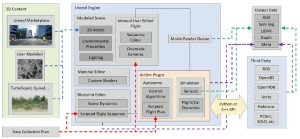
Simulated Photorealistic Deep Learning Framework and Workflows to Accelerate Computer Vision and Unmanned Aerial Vehicle Research
2021 IEEE/CVF International Conference on Computer Vision Workshops (ICCVW), 2021

Abstract
Deep learning (DL) is producing state-of-the-art results in a number of unmanned aerial vehicle (UAV) tasks from low level signal processing to object detection, 3D mapping, tracking, fusion, autonomy, control, and beyond. However, barriers exist. For example, most DL algorithms re-quire big data, but supervised ground truth is a bottle-neck, fueling topics like self-supervised learning. While it is well-known that hardware and data augmentation plays a significant role in performance, it is not well understood which data augmentations or what real data need be collected. Furthermore, existing datasets do not have sufficient ground truth nor variety to support adequate con-trolled experimental research into understanding and mitigating limitations in DL algorithms, models, data, and biases. In this article, we address the combination of photo-realistic simulation, open source libraries, and high quality content (models, materials, and environments) to develop workflows to mitigate the above challenges and accelerate DL-enabled computer vision research. Herein, examples are provided relative to data collection, detection, passive ranging, and human-robot teaming. Online video tutorials are also provided at https://github.com/MizzouINDFUL/UEUAVSim.
Media
Related Work
